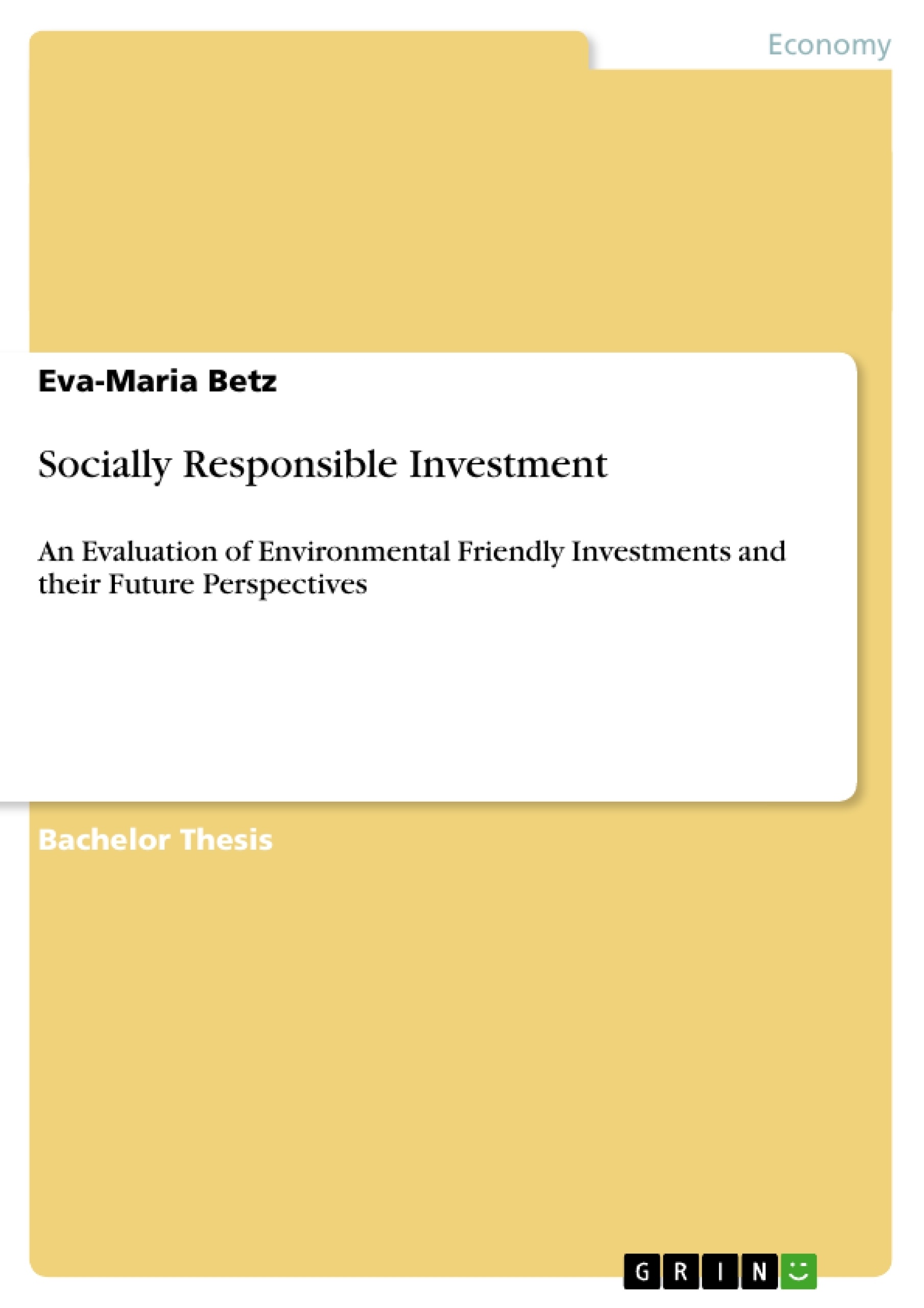The ecologic crisis of our Planet is foreseeable. Making money with it, or even better making money by preventing the disaster, will sell.
This thesis shall evaluate the effectiveness of environmentally friendly investments and provide an outlook on future perspectives.
The topic has become very popular due to a general reorientation to ethical values and particularly, because of the questionable ethical behavior of many financial players in the current world economic crisis.
The indicators reveal a strong and continuous growth in the market of environmentally friendly investments. For this reason, the financial sector now copes with the topic more intensively. Whether this leads to improvements for investors through stronger performance or for managers of sustainable projects due to better financial conditions depends on the developments of standardization and the quality assessment processes.
This work starts with the clearing of uncertainties related to the core terminology and presents the numerous investment possibilities with their corresponding ecological impact.
The main challenge the environmentally friendly investment market is facing, is the need for more transparency; in the assessment criteria and their weighting, in methods, and in the application of funds. Subsequently, the credibility of these investments has to be increased. These statements are confirmed by a survey (cf. chapter 6). The survey reveals furthermore that financial consultants regard the issue as relevant for their job, but lack information to promote these investments.
There is an urgent need to implement new ideas in order to lower the risks for the environment and to satisfy the financial market’s need at the same time. Therefore, concepts are presented that try to meet these demands. The focus lies on a concept as holistic as a Life Cycle Assessment and as measurable as the eMergy coefficient.
Inhaltsverzeichnis (Table of Contents)
- Executive Summary
- Table of Content
- Index of figures
- 1. Introduction
- 2. Basic facts about environmentally friendly investments
- 2.1 Market overview
- 2.2 Definitions of key words
- 2.3 Principles of Responsible Investment and leading Organizations
- 3. Investment forms and their ecological effectiveness
- 3.1 Three categories to rank investment forms by their ecologic effectiveness
- 3.2 Closer analysis of ecological effectiveness of each investment form
- 3.2.1 Bank deposit
- 3.2.2 Credit cards
- 3.2.3 Bonds
- 3.2.3.1 Loans
- 3.2.3.2 Shares
- 3.2.4 Investment funds
- 3.2.5 Hedge Funds
- 3.2.6 Life and health insurances and provisions of retirement
- 4. Investment strategies with sustainable focus
- 4.1 Common strategies in the implementation of sustainability into the asset management
- 4.2 Indices
- 4.2.1 Dow Jones Sustainability Index
- 4.2.2 FTSE 4 Good Index
- 5. The transparency challenge
- 5.1 Quality, objectiveness and expressiveness of information
- 5.2 Costs for transparency
- 6. Survey among financial service providers
- 6.1 Target, Methodology
- 6.2 Participants and their background
- 6.3 Presentation of results
- 6.4 Survey Conclusions
- 7. Calculating an indicator to measure environmental impact
- 7.1 Introduction of the Life Cycle Impact Assessment
- 7.1.1 The implementation of the LCA and the ISO 14040 on the basis of an example of the automotive industry
- 7.2 Critical discus on the Life Cycle Impact Assessment
- 7.3 Integration of ecological impact measurement into financial decisions and daily business life
- 7.1 Introduction of the Life Cycle Impact Assessment
- 8. Conclusion
- 9. Appendix index
- APPENIDX A
- APPENDIX B
- APPENDIX C
- APPENDIX D
- APPENDIX E
- APPENDIX F
- References
- Acknowledgment
Zielsetzung und Themenschwerpunkte (Objectives and Key Themes)
This thesis aims to evaluate the effectiveness of environmentally friendly investments and provide an outlook on future perspectives. The work delves into the growing market of eco-conscious investing, driven by a shift towards ethical values and concerns regarding the financial sector's actions during the global economic crisis. The study explores the challenges and opportunities of this sector, focusing on the need for transparency and the development of standardized assessment criteria.
- The effectiveness of environmentally friendly investments
- Future perspectives of sustainable investing
- The need for transparency and standardization in the environmentally friendly investment market
- The ecological impact of various investment forms
- Investment strategies with a sustainable focus
Zusammenfassung der Kapitel (Chapter Summaries)
This chapter covers the basic facts about environmentally friendly investments, including a market overview, definitions of key terms, and a discussion of the Principles of Responsible Investment and leading organizations in this field.
This chapter presents various investment forms and analyzes their ecological effectiveness. It categorizes investment forms based on their environmental impact and examines specific examples, such as bank deposits, credit cards, bonds, investment funds, and hedge funds.
This chapter discusses investment strategies with a sustainable focus, covering common practices for incorporating sustainability into asset management and analyzing specific indices like the Dow Jones Sustainability Index and the FTSE 4 Good Index.
This chapter focuses on the challenge of transparency in the environmentally friendly investment market. It examines the importance of quality, objectivity, and expressiveness in information, as well as the costs associated with ensuring transparency.
This chapter presents the results of a survey conducted among financial service providers. It analyzes the target group, methodology, participants' backgrounds, and the key findings of the survey, providing insights into the current state of awareness and engagement with environmentally friendly investments.
Schlüsselwörter (Keywords)
The main keywords and focus topics of this work include environmentally friendly investments, sustainable investing, transparency, ecological effectiveness, investment forms, investment strategies, indices, Life Cycle Assessment, and the Emergy coefficient.
- Citation du texte
- Eva-Maria Betz (Auteur), 2009, Socially Responsible Investment, Munich, GRIN Verlag, https://www.grin.com/document/138446



